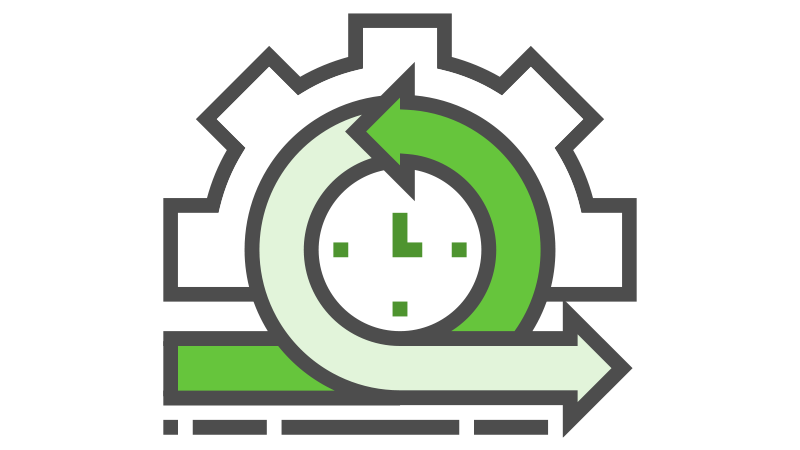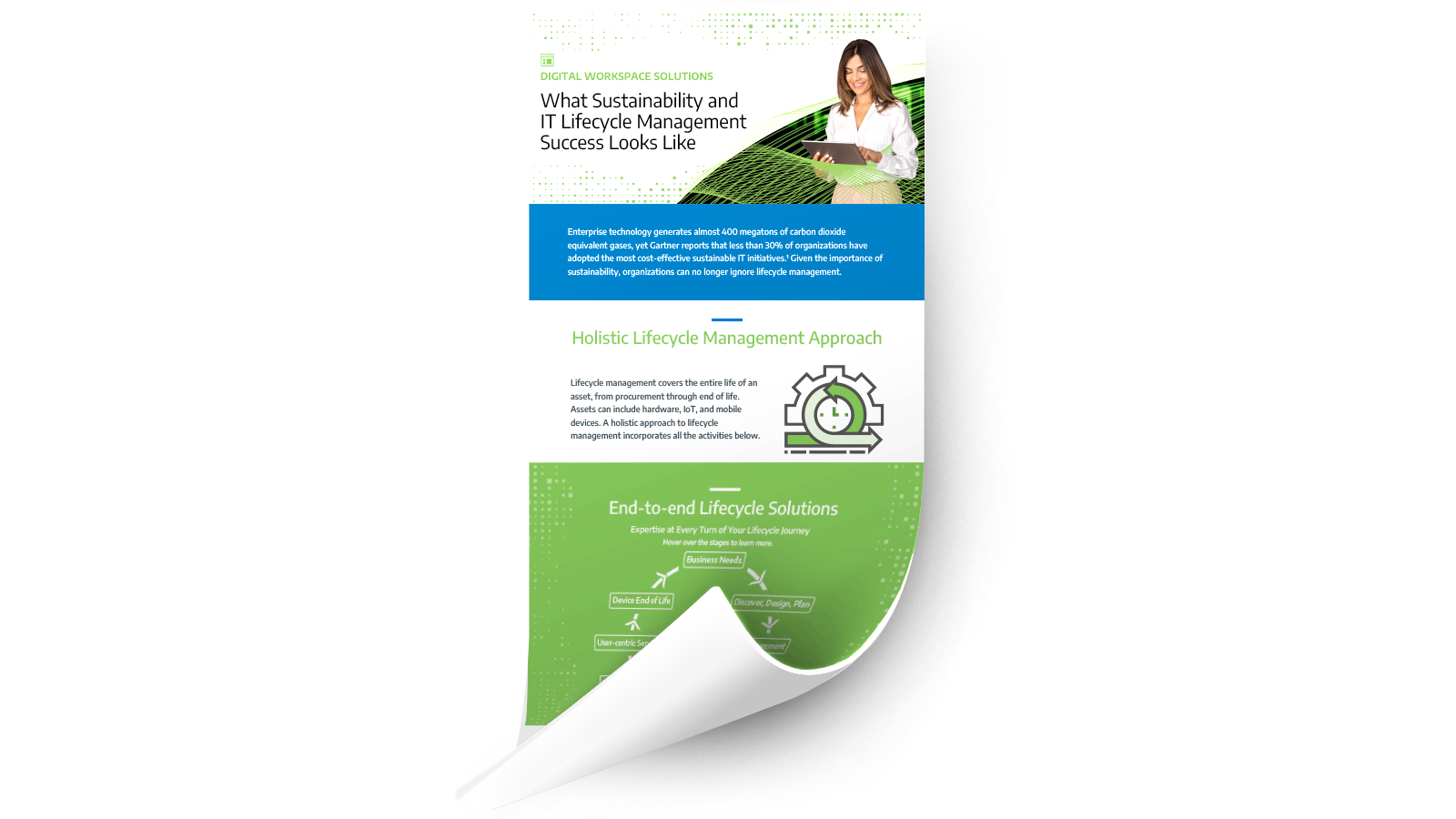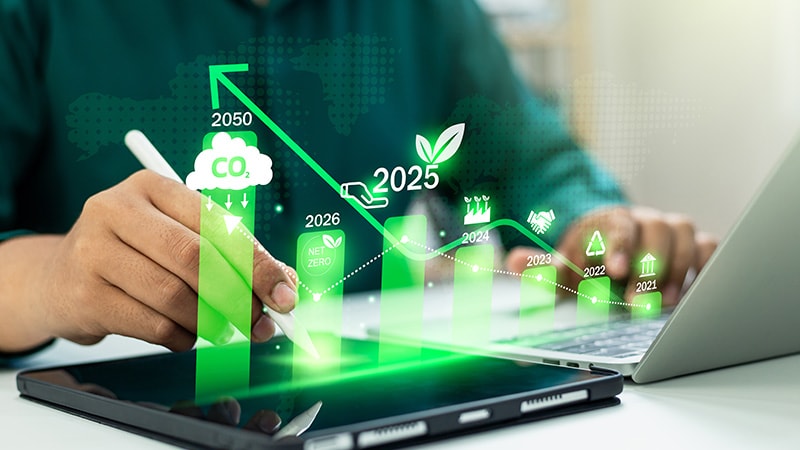- Home
- Solutions and Services
- Digital Workspace
- Sustainability and IT Lifecycle Management: Integrating Environmental Responsibility with IT Operations
Sustainability and IT Lifecycle Management: Integrating Environmental Responsibility with I.T. Operations
Invest in a Brighter Future
Care for the environment is more than just a nice brand promise—it’s now expected by most consumers1 and employees2.Read this article for key insights that include:
- Unlocking the Potential of Sustainability
- Components of a Holistic Lifecycle Management Approach
- Lifecycle Management in Action
- Measuring Success
- Best Practices for Lifecycle Management Implementation
- What Sustainability and IT Lifecycle Management Success Looks Like
- Supporting Your IT Sustainability Journey
Sustainability and IT Lifecycle Management: Integrating Environmental Responsibility with I.T. Operations
Invest in a Brighter Future
Care for the environment is more than just a nice brand promise—it’s now expected by most consumers1 and employees2.Read this article for key insights that include:
- Unlocking the Potential of Sustainability
- Components of a Holistic Lifecycle Management Approach
- Lifecycle Management in Action
- Measuring Success
- Best Practices for Lifecycle Management Implementation
- What Sustainability and IT Lifecycle Management Success Looks Like
- Supporting Your IT Sustainability Journey
Unlocking the Potential of Sustainability
For most companies, regardless of size or industry, IT is a great area to achieve sustainability gains. That’s because enterprise technology generates almost 400 megatons of carbon dioxide equivalent gases.3 Surprisingly, it’s not data centers generating the most emissions. It’s end-user devices, which outnumber data center servers and have short lifespans.Despite this, Gartner reports that less than 30% of organizations have adopted many of the most cost-effective sustainable IT initiatives.4 In its survey, Gartner also found that many leaders neglect low-cost initiatives if they only achieve moderate greenhouse gas reduction. One area that’s often overlooked is lifecycle management, particularly around refurbished assets and device refresh cycles.
When done right, IT lifecycle management (ITLM) is a powerful tool for advancing environmental responsibility. It impacts operational efficiency and waste reduction goals, helping leaders garner stakeholder excitement. However, because lifecycle management spans procurement through end-of-life, it can be challenging for executives to know where to begin.
We recommend starting with an overview of ITLM and then looking at specific use cases for minimizing environmental impact.
Unlocking the Potential of Sustainability
For most companies, regardless of size or industry, IT is a great area to achieve sustainability gains. That’s because enterprise technology generates almost 400 megatons of carbon dioxide equivalent gases.3 Surprisingly, it’s not data centers generating the most emissions. It’s end-user devices, which outnumber data center servers and have short lifespans.Despite this, Gartner reports that less than 30% of organizations have adopted many of the most cost-effective sustainable IT initiatives.4 In its survey, Gartner also found that many leaders neglect low-cost initiatives if they only achieve moderate greenhouse gas reduction. One area that’s often overlooked is lifecycle management, particularly around refurbished assets and device refresh cycles.
When done right, IT lifecycle management (ITLM) is a powerful tool for advancing environmental responsibility. It impacts operational efficiency and waste reduction goals, helping leaders garner stakeholder excitement. However, because lifecycle management spans procurement through end-of-life, it can be challenging for executives to know where to begin.
We recommend starting with an overview of ITLM and then looking at specific use cases for minimizing environmental impact.

Advancing Environmental Responsibly through Measurable IT Lifecycle Strategies
Change Happens. EXPERTISE WINS.™
Explore how Connection can support your IT lifecycle management.Talk to an Expert
Components of a Holistic Lifecycle Management Approach
First up are procurement and deployment. This category includes purchasing, warehousing, device setup, refreshes, and deployment services.
In the asset tracking category, each asset is inventoried with serial numbers. This step is crucial for managing large asset deployments or fluid workforces where equipment is frequently returned and redeployed.
Once assets are deployed, their use needs to be optimized. You can extend asset life, provide better ROI, and improve end-user satisfaction with a proactive maintenance plan.
Finally, when assets reach the end of their life, there should be a process and certified partners to help them exit the organization. This process should ensure data security, issue death certificates and certificates of destruction, and prevent the assets from ending up in landfills. One way to achieve zero landfill is to focus on value recovery. The options include resale, donation, and recycling. Not only are these approaches better for the environment, but they also offer opportunities to recoup some of the initial investment.
With this holistic approach in mind, let’s explore how these services work in the real world.

Lifecycle Management in Action
With large deployments, lifecycle services simplify complex projects, making them more sustainable, efficient, and cost-effective. They achieve this by consolidating packing and transport, reducing shipping costs, and minimizing the number of recyclables left in the field.
For relocations or consolidations, ITLM creates an asset inventory, a disposal list and plan, and a resale plan. Companies are no longer left guessing what assets they have, where they are, or whether they will still serve a purpose moving forward.

Measuring Success
One of the statistics many companies track is material diverted from landfills. This material is sometimes referred to as e-waste or electronic waste. You can calculate your waste diversion rate by determining the percentage of total waste diverted through resale, donation, and recycling. Refurbishment success rate and packaging reuse or recycling rates are two helpful measurements to add to your KPI list.
Another common sustainability goal is reducing the company’s carbon footprint. Carbon emissions are often tracked at the corporate level as part of environmental, social, and governance (ESG) efforts. IT creates both direct carbon emissions from the electricity needed for IT operations and indirect emissions from procurement and disposal.5 By tracking energy consumption, transportation emissions, and waste, IT leaders can calculate their contribution to the company’s carbon footprint. Implementing more efficient shipping and asset maintenance as part of a lifecycle management program can help reduce emissions to meet broader company goals.
Time to value (TTV) is a really helpful KPI. It measures the time it takes for your business to see the benefit of the investment in lifecycle services. Calculating TTV before implementation helps leadership identify which services to prioritize based on company objectives.

Best Practices for Lifecycle Management Implementation
Another consideration is how to staff and manage your ITLM services. Will you run them in-house or find a partner who specializes in lifecycle management? The in-house option may work well for point solutions, but it can be difficult to achieve with more comprehensive programs. Going with a partner can also bring significant savings. You no longer need to recruit and staff services, invest in warehouse space and other supply chain partnerships, or undergo costly certification processes. Here are the key considerations for outsourcing Lifecyle Management.
If you go with a partner, you’ll want to look beyond just price. Find a partner with the proper certifications, such as zero landfill or zero waste, and the tracking and reporting capabilities to provide you with full transparency. The right partner will also have trustworthy inventory housing and auditing capabilities that ensure your assets are protected and accounted for in a timely manner.

What Sustainability and IT Lifecycle Management Success Looks Like
Enterprise technology generates almost 400 megatons of carbon dioxide equivalent gases, yet Gartner reports that less than 30% of organizations have adopted the most cost-effective sustainable IT initiatives. Read this infographic to gain practical insights for simplifying complex IT projects while minimizing environmental impact.
Supporting Your IT Sustainability Journey
Whether you’re just starting with disposal or looking to build out a comprehensive program, Connection can guide you through the ITLM4 journey. Our team customizes solutions based on your operational needs and sustainability goals, with both point solutions and comprehensive approaches. Connection’s robust partner ecosystem already includes zero-landfill partners and other certified providers needed to achieve ESG goals.
Our focus on Quality-as-a-Mindset™ is what truly sets us apart. It’s built into our culture and empowers each employee to take ownership of quality. An example of this methodology is our inventory counts, which we perform four times a year. These proactive counts mean customers don’t have to conduct additional audits or wonder where their assets are. You have complete transparency when warehousing assets with us.
ITLM is a great place to start if you want to drive customer loyalty and employee buy-in through sustainability efforts.

How Connection Can Help
Connection is your partner for IT Lifecycle Management services.Our Managed Digital Workspace solutions span Managed Device Lifecycle solutions, Service Desk, and IT Staffing solutions.
Explore our Solutions and Services
Lifecycle Services
Managed Digital Workspace
Contact an Expert
1.800.998.0067
Connection Community
Beyond Procurement: A Holistic Approach to...
I recently visited one of my favorite big box furniture stores. I walked the vignettes, considering which design I thought... Read More
From Burnout to Breakthrough: How Clinical...
Healthcare workers enter their profession to provide patient care, but they spend an increasing portion of their shifts wrestling with... Read More
Preparing for Microsoft Volume Licensing...
The world of Microsoft licensing is evolving once again, and this time the changes are both sweeping and significant for... Read More
Why Healthcare Needs UCaaS Now More Than Ever
Unified communications as a service (UCaaS) is rapidly becoming essential in healthcare, offering scalable, secure, and patient-centric solutions. As healthcare... Read More
The Indispensable Human Element in Software...
In the rapidly developing landscape of technology, the role of software asset management (SAM) has become increasingly significant. As organizations... Read More
Ready to talk about Digital Workspace Solutions?
Call a Connection expert today.
Expert Advice Is Just a Click Away!
- Getty Images, 2025, Sustainability at the Crossroads: Visualizing Sustainability
- Deloitte, 2025, 2025 Gen Z and Millennial Survey
- McKinsey Digital, 2022, The green IT revolution: A blueprint for CIOs to combat climate change
- Gartner, 2024, Gartner Says Most Cost-effective Sustainable IT Initiatives Are Underutilized
- McKinsey Digital, 2022, The green IT revolution: A blueprint for CIOs to combat climate change




